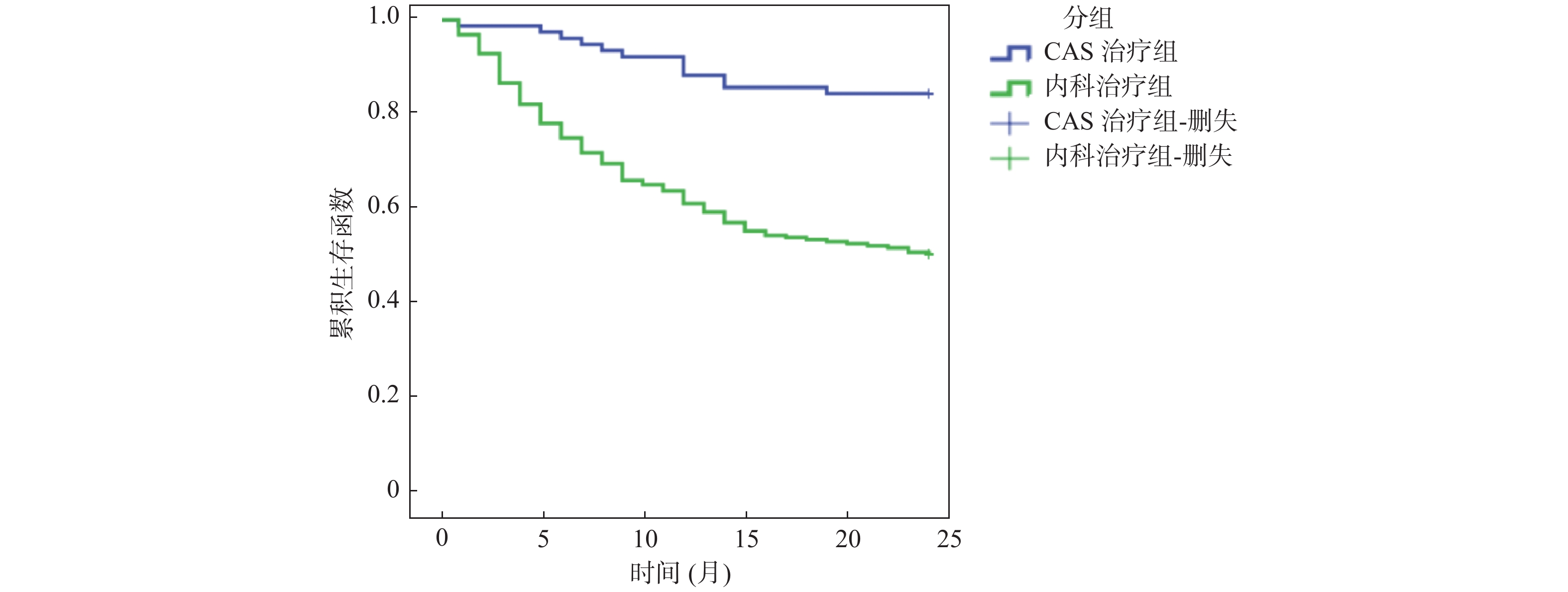Related Factors Affecting Adverse Events of Symptomatic Carotid Artery Stenosis
-
摘要:
目的 研究影响症状性颈动脉狭窄不良事件的相关因素,探讨支架血管成形术对症状性颈动脉狭窄不良事件的影响及事件相关诱发电位对不良事件的诊断价值。 方法 回顾性收集昆明医科大学附属延安医院神经内科及外科302例症状性颈动脉狭窄患者,根据不良事件分为正常组及不良事件组,收集2组患者年龄、性别、血红蛋白、血小板计数、血糖、总胆固醇、甘油三酯、治疗方式、事件相关诱发电位、颈动脉狭窄程度,进行统计学分析。 结果 颈动脉球囊扩张和支架血管成形术(carotid artery stent,CAS)是症状性颈动脉狭窄不良事件的保护因素(P < 0.001),事件相关诱发电位(event-related evoked potential,ERP)(P = 0.007)、颈动脉狭窄程度(P < 0.001)、总胆固醇(P = 0.001)是症状性颈动脉狭窄不良事件的危险因素,事件相关诱发电位对不良事件诊断试验:灵敏度 = 0.70,特异度 = 0.78,颈动脉球囊扩张和支架血管成形术减少不良事件的发生优于内科治疗(P < 0.001)。 结论 颈动脉球囊扩张和支架血管成形术能减少症状性颈动脉狭窄不良事件的发生,事件相关诱发电位对评判症状性颈动脉狭窄预后有一定的指导意义。 Abstract:Objective To study the related influencing factors of adverse events of symptomatic carotid stenosis, and to explore the effect of stenting on adverse events of symptomatic carotid stenosis and the value of event-related evoked potentials in the diagnosis of adverse events. Methods 302 patients with symptomatic carotid artery stenosis in our hospital were divided into normal group and adverse event group according to the adverse events. The age, gender, hemoglobin, platelet count, blood glucose, total cholesterol, TG, treatment, event-related potentials and the degree of carotid artery stenosis were collected and analyzed statistically. Results Carotid balloon dilatation and stenting were protective factors for adverse events of symptomatic carotid stenosis. Event-related evoked potentials, degree of carotid stenosis and total cholesterol were risk factors for adverse events of symptomatic carotid stenosis. The sensitivity and specificity of event-related evoked potentials in the diagnosis of symptomatic carotid stenosis were 0.70 and 0.78, respectively. Carotid balloon dilatation and stenting are superior to medical treatment in reducing the incidence of adverse events. Conclusions Carotid balloon dilatation and stenting can reduce the occurrence of adverse events of symptomatic carotid stenosis. Event-related evoked potentials have certain guiding significance in judging the prognosis of symptomatic carotid stenosis. -
Key words:
- Adverse event /
- Carotid artery stent /
- Event-related evoked potential /
- Diagnostic value
-
表 1 2组患者一般情况比较[
$\bar x \pm s$ /n(%)]Table 1. Comparison of the general condition of patients between the two groups [
$\bar x \pm s$ /n(%)]指标 正常组(n = 179) 不良事件组(n = 123) t/χ2 P 年龄(岁) 55.35 ± 11.41 57.46 ± 12.08 −0.988 0.325 性别 2.480 0.115 男 98(54.75) 56(45.53) 女 81(45.25) 67(54.47) 血红蛋白(g/L) 150.15 ± 18.40 152.00 ± 16.94 −0.318 0.752 血小板计数(×109/L) 245.89 ± 99.89 214.74 ± 71.90* −2.288 0.023 血糖(mmol/L) 6.51 ± 3.51 5.89 ± 3.58 0.979 0.329 总胆固醇(mmol/L) 3.11 ± 1.00 3.71 ± 1.14* −3.088 0.002 甘油三酯(mmol/L) 1.25 ± 0.61 1.35 ± 0.81 −0.720 0.473 治疗方式 27.067 < 0.001 CAS治疗 65(36.31) 12(9.76)** 内科治疗 114(63.69) 111(90.24) 事件相关诱发电位 71.826 < 0.001 正常 140(78.21) 36(29.27)** 异常 39(21.79) 87(70.73) 颈动脉狭窄程度 6.982 0.008 中度狭窄 99(55.31) 49(39.84)* 重度狭窄 80(44.69) 74(61.16) 与正常组比较,*P < 0.05,**P < 0.001。 表 2 影响症状性颈动脉狭窄不良事件赋值表
Table 2. Assignment table of adverse events affecting symptomatic carotid stenosis
变量 赋值 血小板计数 连续变量 总胆固醇 连续变量 治疗方式 1 = CAS治疗,2 = 内科治疗 事件相关诱发电位 1 = 正常,2 = 异常 颈动脉狭窄程度 1 = 中度狭窄,2 = 重度狭窄 因变量 1 = 正常组,2 = 不良事件组 表 3 影响症状性颈动脉狭窄不良事件的二分类Logistic回归分析
Table 3. Binary logistic regression analysis of adverse events in symptomatic carotid artery stenosis
影响因素 B SE Wald P 0R 95%CI 治疗方式(CAS治疗) −1.72 0.59 6.34 0.003 0.18 0.06-0.56 事件相关诱发电位(异常) 1.29 0.48 7.36 0.007 3.64 1.43-9.23 颈动脉狭窄程度(重度狭窄) 1.36 0.73 16.38 < 0.001 4.07 2.91-7.92 总胆固醇 0.09 0.03 11.75 0.001 1.09 1.04-1.15 常量 2.28 4.45 0.26 0.607 − − 表 4 事件相关诱发电位诊断试验[n(%)]
Table 4. Event-related evoked potential diagnostic test [n(%)]
诊断试验 金标准 合计(n) 不良事件组 正常组 事件相关诱发电位异常组 87(70.73) 39(21.79) 126 事件相关诱发电位正常组 36(29.27) 140(78.21) 176 合计 123 179 302 -
[1] 中华医学会外科学分会血管外科学组. 颈动脉狭窄诊治指南[J]. 中华血管外科杂志,2017,2(2):78-84. [2] 王陇德,刘建民,等. 《中国脑卒中防治报告2017》概要[J]. 中国脑血管病杂志,2018,15(11):611-616. doi: 10.3969/j.issn.1672-5921.2018.11.010 [3] 中华医学会神经病学分会. 中华医学会神经病学分会脑血管病学组,中国重症脑血管病管理共识[J]. 中华神经科杂志,2016,49(3):192-202. doi: 10.3760/cma.j.issn.1006-7876.2016.03.004 [4] Jauch E C,Saver J L,Adams H P Jr,et al. Guidelines for the early management of patients with acute ischemic stroke:a guideline for healthcare professionals from the American Heart Association/American Stroke Association[J]. Stroke,2013,44(3):870. doi: 10.1161/STR.0b013e318284056a [5] 中华医学会神经病学分会. 中华医学会神经病学分会脑血管病学组,中国急性缺血性脑卒中诊治指南[J]. 中华神经科杂志,2018,59(9):666-682. doi: 10.3760/cma.j.issn.1006-7876.2018.09.004 [6] 田剑光,曹旭华,李琛,等. 症状性颈动脉狭窄合并同侧未破裂动脉瘤的手术治疗[J]. 脑与神经疾病杂志,2017,25(3):179-182. [7] Nomani F,Kamal A K. Citicoline in the treatment of acute ischaemie stroke:an international,randomized,muhieentre,placebo-controlled study (ICTUS trial) is the use of Citicoline is beneficial for acute ischaemic stroke?[J]. J Pak Med Assoc,2013,63(11):14J45. [8] 车锋,马乾,王荔,等. 老年无症状性脑梗死与颈动脉粥样硬化的相关性研究[J]. 中国药物与临床,2019,19(4):592-594. [9] 李顺钧,王慧,蒋艳艳,等. 无卒中晚发型抑郁患者危险因素及临床特征分析[J]. 脑与神经疾病杂志,2018,26(4):250-255. [10] Brand N,Bossema E R,Ommen M V,et al. Left or right carotid endarterectomy in patients with atherosclerotic disease:Ipsilateral effects on cognition?[J]. Brain and Cognition,2004,54(2):117-112. doi: 10.1016/j.bandc.2003.12.001 [11] Bossema E R,Brand N,Moll F L,et al. Cognitive functions in carotidartery disease before endarterectomy[J]. Journal of Clinical and Experimental Neuropsychology,2006,28(3):357-369. doi: 10.1080/13803390590935318 [12] Romero J R,Beiser A,Seshadri S,et al. Carotid artery atherosclerosis,MRI indices of brain ischemia,aging,and cognitive impairment:The Framingham study[J]. Stroke,2009,40(5):1590-1596. doi: 10.1161/STROKEAHA.108.535245 [13] Sztriha L K,Nemeth D,Sefcsik T,et al. Carotid stenosis and the cognitive function[J]. J Neurol Sci,2009,283(1-2):36-40. doi: 10.1016/j.jns.2009.02.307 [14] Kim J E. Cognitive dysfunction in 16 patients with carotid stenosis:Detailed neuropsychological findings[J]. J Clin Neurol,2007,3(1):9-17. doi: 10.3988/jcn.2007.3.1.9 [15] Crawley F,Stygall J,Lunn S,et al. Comparison of microembolism detected by transcranial Doppler and neuropsychological sequelae of carotid surgery and percutaneous transluminal angioplasty[J]. Stroke,2000,31(6):1329-1334. doi: 10.1161/01.STR.31.6.1329 [16] Thomas G,Brott,Jonathan L,et al. Guideline on the management of patients with extracranial carotid and vertebral artery disease[J]. Stroke,2011,42:e464-e540. [17] Wijdicks E F,Sheth K N,Carter B S,et a1. Recommendations for the management of cerebral and cerebellar infarction with swelling:a statement for healtheare professionals from the American Heart Association/American Stroke Association[J]. Stroke,2014,45(4):1222-1238. doi: 10.1161/01.str.0000441965.15164.d6 [18] 王晓虹,王苏平,王翠,等. 颅内外动脉粥样硬化狭窄分布与脂蛋白胆固醇及载脂蛋白的关系[J]. 脑与神经疾病杂志,2016,24(6):349-354. [19] 孙平霞,闫中瑞,岳红梅,等. 高血压与老年性认知障碍相关性研究[J]. 济宁医学院学报,2013,36(1):43-45. doi: 10.3969/j.issn.1000-9760.2013.01.013 [20] Campanella S. Why it is time to develop the use of cognitive event-related potentials in the treatment of psychiatric diseases[J]. Neuropsychiatr Dis Treat,2013,9:1835-1845. [21] 刘磊,徐飞,李妍平. 首发抑郁症患者服药前后MMSE、HAMD与ERP的对比研究[J]. 癫痫与神经电生理学杂志,2015,24(1):5-9. [22] Vander Stelt O,Belger A. Application of electroencepholography to the study of cognitive and brain functions in schizophrenia[J]. Schizophr Bull,2007,33(4):955-970. doi: 10.1093/schbul/sbm016 [23] Polich J. Updating P300:an integrative theory of P3a and P3b[J]. Clin Neurophysiol,2007,118(10):2128-2148. doi: 10.1016/j.clinph.2007.04.019 -






 下载:
下载:




